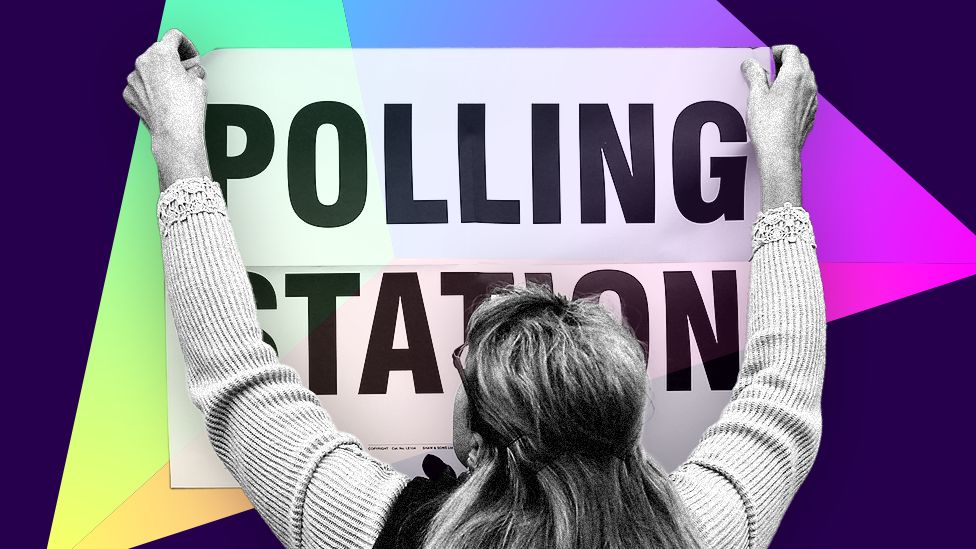A simple guide to the 4 July general election

Millions of voters have the chance to take part in Thursday’s general election.
They will elect their local MP and help choose the UK’s next government.
Some councils have made special arrangements to issue replacement postal-vote packs, after reported delays in Scotland and parts of England.
What time do polling stations open and close, and how do I find mine?
Polling stations open on Thursday 4 July at 07:00 BST and close at 22:00. You can vote as long as you are in the queue by 22:00.
You can only vote at your local polling station, which might not be the same as in previous elections.
The address is on your polling card, or you can find details online.
-
Can I take children or pets to a polling station?
-
How does the BBC report polling day?
How do general elections work and what constituency am I in?
The UK is divided into 650 areas, called constituencies.
In a general election, voters in each constituency choose a Member of Parliament – or MP – to represent them in the House of Commons.
Most candidates belong to a particular political party, but some are independent.
Each person has one vote. Under a system called “first past the post”, the candidate with the most votes becomes the MP for that area.
The party with the most MPs typically forms the next government, and its leader usually becomes the prime minister.
This general election uses new constituency boundaries, redrawn to reflect population changes and to even out voter numbers.
Enter your postcode in our tool to find out which constituency you are in and who you can vote for. Or you can browse all the constituencies on our A-Z page.

What photo ID do I need to vote?
Under rules introduced in May 2023, voters in England, Scotland and Wales have to show valid photo ID to vote in person at a general election.
You do not need to take your polling card.
There are 22 acceptable forms of ID, including passports and driving licences. You can use expired photo ID as along as you are still recognisable.
Voters in England, Scotland and Wales whose ID has been lost or stolen can apply for an emergency proxy vote until 17:00 on polling day. A proxy is someone else you nominate to vote on your behalf.
Both you and your proxy must be registered to vote.
The rules are different in Northern Ireland, where voters have had to show photo ID since 2003.
-
What photo ID will you need to vote in the general election?
What if my postal vote has not arrived and how can I return mine?
A replacement voting pack can be issued by your local council’s returning officer until 17:00 on Thursday.
Contact your council’s electoral services team as soon as possible – replacement packs won’t be available at polling stations.
For your vote to be counted, you can hand in your completed form to your polling station before 22:00 on Thursday. Or you can take it to the address on your postal voting pack during office hours this week, before 17:00 on polling day. You don’t need ID, but you must sign a form.
You can also drop off up to five completed postal vote packs for friends and family.
Political candidates and party campaigners are only allowed to handle postal votes for close family members, or someone they regularly care for.
In Northern Ireland, campaigners cannot handle another person’s postal vote, and postal votes cannot be accepted at polling stations.
Some Scottish councils have created emergency voting booths for people who will be on holiday.
In certain circumstances, voters in England, Scotland and Wales can nominate an emergency proxy to vote for them. However, the Electoral Commission, which oversees UK elections, has confirmed the non-arrival of a postal vote does not qualify.
What if I don’t have a postal vote but can’t get to the polling station on 4 July?
You can also request an emergency proxy vote if last-minute work commitments or a medical emergency mean you can no longer vote in person.
You can apply for this up to 17:00 on polling day in England, Scotland and Wales.
People whose postal votes have not arrived cannot use an emergency proxy vote.
What happens after the election results are announced?
After the votes have been counted, the King typically asks the leader of the party with the most MPs to become prime minister and to form a government.
The leader of the party with the second highest number of MPs usually becomes the leader of the opposition.
If no party ends up with a majority of MPs – meaning it cannot pass legislation with just its own MPs – the result is a hung Parliament.
At this point, the largest party might decide to form a coalition government with another party or operate as a minority government, relying on votes from other parties to pass laws.
The new Parliament will meet on 9 July, when it will elect a Speaker and swear in members.
This will be followed on 17 July by the State Opening of Parliament and the King’s Speech, when the government outlines its priorities.
How often are general elections held?
The latest a Parliament can be dissolved for a general election is on the fifth anniversary of the day it first met.
However, 25 working days are then allowed to prepare for the election.
The prime minister can call the election at a time of their choosing, within the five-year period.
Related Topics
- UK government
- UK Parliament
- General election 2024
Published at Wed, 03 Jul 2024 09:15:04 +0000

